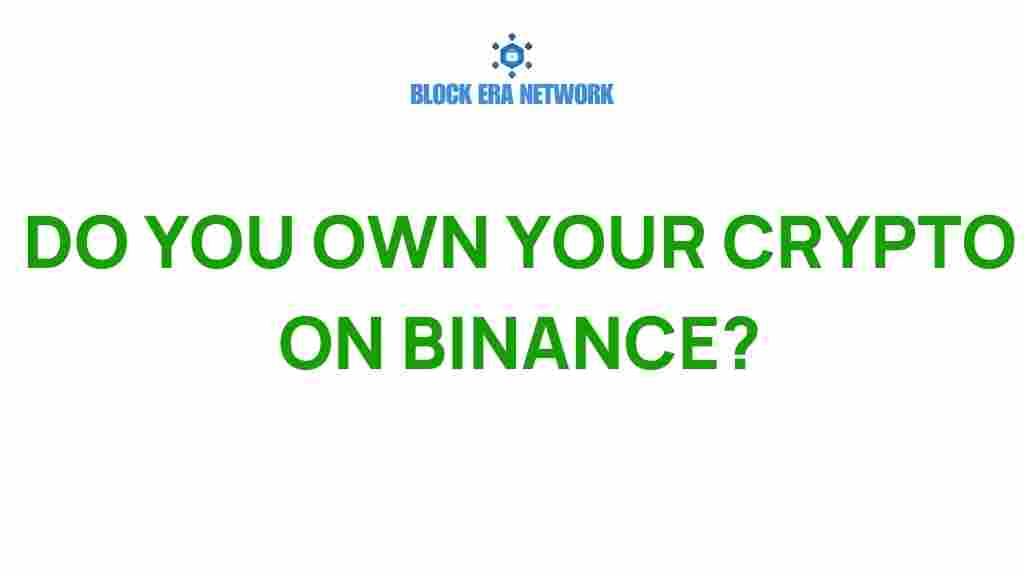Do You Truly Own Your Crypto on Binance? Unpacking the Myths
The rise of cryptocurrency has transformed the financial landscape, leading many to ask critical questions about crypto ownership. One of the most popular exchanges for trading digital assets is Binance, but do users really own their cryptocurrencies when using this platform? This article aims to unpack the myths surrounding crypto ownership on Binance, exploring aspects of exchange security, user rights, and asset custody.
Understanding Crypto Ownership
At its core, crypto ownership refers to the rights and control an individual has over their digital assets. This ownership is primarily determined by how cryptocurrencies are stored and managed. The most common forms of storage include:
- Hot wallets: These are online wallets that are connected to the internet, making them convenient but also vulnerable to hacks.
- Cold wallets: These are offline storage methods, such as hardware wallets, that offer enhanced security against online threats.
- Exchange wallets: When you hold your digital assets on an exchange like Binance, your coins are stored in their wallets.
Understanding where and how your cryptocurrencies are stored is crucial to grasping the implications of ownership.
Binance and Digital Assets
Binance is one of the largest cryptocurrency exchanges globally, facilitating trading in hundreds of cryptocurrencies. However, this raises important questions regarding asset custody:
- Who holds your keys? In crypto, the phrase “not your keys, not your coins” is a common mantra. When you store your assets on Binance, the platform holds the private keys to your cryptocurrencies.
- What happens during a hack? Exchanges are targets for hackers. In the past, Binance has experienced security breaches, leading to significant losses for users.
- Withdrawal restrictions: Exchanges can impose limits on withdrawals, impacting your ability to access your funds instantly.
Each of these points raises concerns about true crypto ownership on platforms like Binance.
The Blockchain Factor
One of the fundamental principles of cryptocurrencies is the underlying blockchain technology, which provides decentralization and security. When you own cryptocurrency, you typically have control over your private keys, allowing you to manage your assets freely. However, when you trade on Binance:
- Your assets are stored in their wallets, which means you do not have direct control over the private keys.
- Transactions are recorded on the blockchain, but your relationship with those assets is mediated by Binance.
This distinction is crucial for understanding crypto ownership.
What Are Your Rights as a User?
Users of Binance and other cryptocurrency exchanges should be aware of their rights, which are often defined in the platform’s terms of service. Here are some key considerations:
- Access to funds: While you can trade and manage your assets, your access to those funds is subject to the exchange’s policies.
- Security measures: Exchanges implement various security protocols, but users should also take steps to secure their accounts.
- Customer support: In case of issues, users have the right to seek assistance from Binance’s customer support.
Understanding your rights can empower you to make informed decisions about your digital assets.
Step-by-Step Process to Secure Your Crypto on Binance
To ensure the best possible security and ownership of your cryptocurrencies on Binance, follow these steps:
Step 1: Enable Two-Factor Authentication (2FA)
Enabling 2FA on your Binance account is a crucial step to enhance security. This adds an extra layer of protection by requiring a second form of verification.
Step 2: Use a Strong Password
Always create a strong, unique password for your Binance account. Avoid common phrases and include a mix of letters, numbers, and special characters.
Step 3: Regularly Monitor Account Activity
Keep an eye on your account activity. Regularly check for any unauthorized transactions and report them immediately.
Step 4: Withdraw to a Personal Wallet
If you are serious about crypto ownership, consider withdrawing your assets to a personal wallet where you control the private keys. This minimizes the risks associated with exchange security.
Step 5: Educate Yourself
Stay informed about the latest security practices and scams in the cryptocurrency space. Knowledge is a powerful tool for protecting your assets.
Troubleshooting Common Issues
Even with the best practices in place, users may encounter issues. Here are some common problems and their solutions:
- Problem: Unable to withdraw funds.
- Solution: Check if there are any withdrawal limits imposed by Binance. Ensure your account is verified.
- Problem: Suspicious account activity.
- Solution: Immediately change your password and enable 2FA. Contact Binance support to report the issue.
- Problem: Lost access to 2FA method.
- Solution: Use Binance’s recovery methods to regain access. This may involve identity verification.
Conclusion: Understanding Your Crypto Ownership on Binance
In conclusion, while Binance offers a convenient platform for trading and managing cryptocurrencies, it’s essential to understand the nuances of crypto ownership on such exchanges. The platform provides a user-friendly interface but does not grant users full control over their digital assets.
By following the steps outlined in this article, you can enhance the security of your assets and make informed decisions about how to manage your cryptocurrencies effectively. Remember that true ownership often means taking custody of your assets in a way that aligns with the principles of decentralization that blockchain technology offers.
For more information on cryptocurrency security and management, check out this comprehensive guide.
As the crypto landscape continues to evolve, staying educated and proactive about your rights and the security of your assets on platforms like Binance is vital for anyone looking to navigate this exciting but complex world of digital assets.
This article is in the category Crypto Security and created by Block Era Network Team
